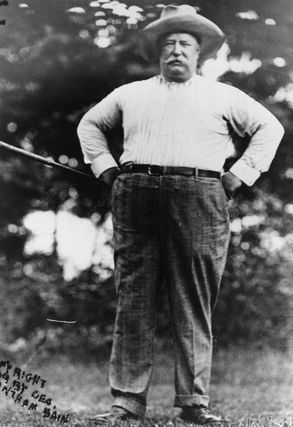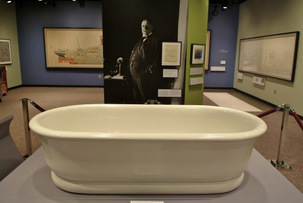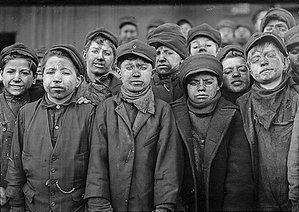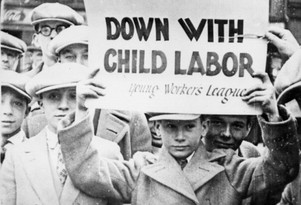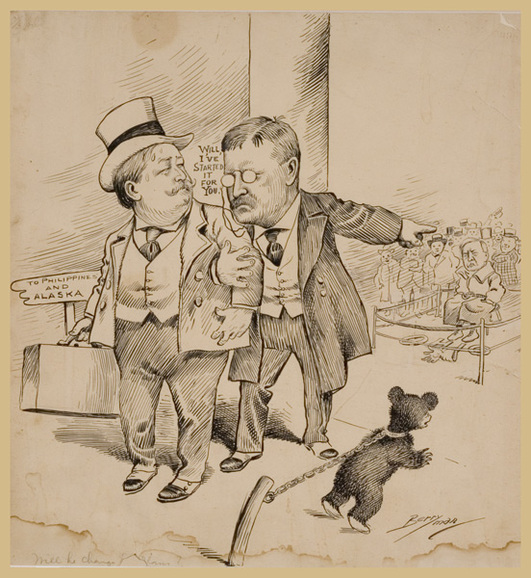Taft As President |
WillIam TaftBACKGROUND, EXPERIENCES AND PERSONALITYBorn in the Mount Auburn section of Cincinnati, Ohio, on September 15, 1857, William Howard Taft was a physically active child, playing sports and taking dancing lessons despite his tendency to obesity. (Rumor had it he was so large he got stuck in bathtub as president.) He loved baseball, and he was a good second baseman and a power hitter. Taft studied at Woodward High School, a well-regarded private school in Cincinnati, graduating in 1874 second in the class. He attended Yale and graduated second in his class then went on to the University of Cincinnati Law School.
Due to his father's political connections, Taft became assistant prosecutor (lawyer) of Hamilton County, Ohio, in 1881. Thereafter, he worked as a lawyer for a few years before being appointed judge of the Cincinnati Superior Court in 1887. In 1892 Taft accepted appointment as a judge of the Sixth U.S. Circuit Court of Appeals with jurisdiction over Ohio, Michigan, Kentucky, and Tennessee. He later would step down from the court of appeals and become Governor General of the Philippines after the US Victory in Spanish-American War. While in the Philippines, Taft had twice turned down President Roosevelt's offer of a Supreme Court appointment in order to finish his work in the Islands. Taft was loved and supported by many Filipino residents for his evenhanded governance. In Taft's own view, the Filipinos were not yet capable of governing themselves, and he believed that it would take years before self-rule would work. Eventually he would become become Roosevelt's secretary of war, Nellie Taft would have urged her husband to stay in the Philippines. Taft accepted Roosevelt's offer because he believed that as secretary of war he would continue to oversee affairs in the Islands. During his four years as secretary of war (1904-1908), Taft became Roosevelt's chief agent and confidant. President Roosevelt made him Secretary of War, and by 1907 had decided that Taft should be his successor. The Republican Convention nominated him the next year. Taft disliked the campaign--"one of the most uncomfortable four months of my life." But he pledged his loyalty to the Roosevelt program, popular in the West |
Taft Continues Reforms
Progressives were pleased with Taft's election. "Roosevelt has cut enough hay," they said; "Taft is the man to put it into the barn." Conservatives were delighted to be rid of Roosevelt--the "mad messiah."Taft recognized that his techniques would differ from those of his predecessor. Unlike Roosevelt, Taft did not believe in the stretching of Presidential powers. He once commented that Roosevelt "ought more often to have admitted the legal way of reaching the same ends."
Taft alienated many liberal Republicans who later formed the Progressive Party, by defending the Payne-Aldrich Act which unexpectedly continued high tariff rates. A trade agreement with Canada, which Taft pushed through Congress, would have pleased eastern advocates of a low tariff, but the Canadians rejected it. He further antagonized Progressives by upholding his Secretary of the Interior, accused of failing to carry out Roosevelt's conservation policies.
After Roosevelt served two terms, he supported William Howard Taft, a member of his cabinet and a former judge from Ohio, to succeed him in 1908. Roosevelt was confident that Taft would continue his reform program. The two men could not have been more different. Roosevelt was outspoken and loved the limelight, while Taft was quiet and reserved. Whereas Roosevelt took bold actions, Taft was cautious. In short, Taft was a reluctant, lackluster campaigner.Nevertheless, Roosevelt's support helped him sail to victory.
As president, Taft continued reform efforts. He fought to limit the power of big corporations and added land to the national forest system. However, on other issues Taft parted company with progressive reformers. Progressives wanted lower tariffs on imported goods. Lower tariffs would make foreign products less expensive for American consumers. They would also increase competition, so that American producers would have to lower prices. Big business favored high tariffs. Taft had campaigned for president on a low-tariff platform, but in 1909 he agreed to sign the Payne-Aldrich Bill, which raised tariffs. This action tarnished Taft's record as a progressive.
Progressives were pleased with Taft's election. "Roosevelt has cut enough hay," they said; "Taft is the man to put it into the barn." Conservatives were delighted to be rid of Roosevelt--the "mad messiah."Taft recognized that his techniques would differ from those of his predecessor. Unlike Roosevelt, Taft did not believe in the stretching of Presidential powers. He once commented that Roosevelt "ought more often to have admitted the legal way of reaching the same ends."
Taft alienated many liberal Republicans who later formed the Progressive Party, by defending the Payne-Aldrich Act which unexpectedly continued high tariff rates. A trade agreement with Canada, which Taft pushed through Congress, would have pleased eastern advocates of a low tariff, but the Canadians rejected it. He further antagonized Progressives by upholding his Secretary of the Interior, accused of failing to carry out Roosevelt's conservation policies.
After Roosevelt served two terms, he supported William Howard Taft, a member of his cabinet and a former judge from Ohio, to succeed him in 1908. Roosevelt was confident that Taft would continue his reform program. The two men could not have been more different. Roosevelt was outspoken and loved the limelight, while Taft was quiet and reserved. Whereas Roosevelt took bold actions, Taft was cautious. In short, Taft was a reluctant, lackluster campaigner.Nevertheless, Roosevelt's support helped him sail to victory.
As president, Taft continued reform efforts. He fought to limit the power of big corporations and added land to the national forest system. However, on other issues Taft parted company with progressive reformers. Progressives wanted lower tariffs on imported goods. Lower tariffs would make foreign products less expensive for American consumers. They would also increase competition, so that American producers would have to lower prices. Big business favored high tariffs. Taft had campaigned for president on a low-tariff platform, but in 1909 he agreed to sign the Payne-Aldrich Bill, which raised tariffs. This action tarnished Taft's record as a progressive.
Addressing IndustrializationProtecting Consumers & Workers
Under Taft, the Justice Department brought 90 lawsuits against trusts—more than twice the number under Roosevelt. Taft supported a stricter interpretation of the Sherman Anti Trust Act. Roosevelt distinguished between good and bad trusts, trying to break up only trusts created specifically to squash competition. In contrast, Taft did not think a court could determine a trust's motives, so he prosecuted any trusts that had the effect of limiting trade, regardless of intent. Roosevelt also helped improve working conditions for coal miners. In 1902, he pressured coal mine owners and the striking United Mine Workers to submit to arbitration, a legal process in which a neutral outside party helps resolve a dispute. A government commission decided that the miners should have higher wages and shorter hours. However, it also declared that the owners did not have to recognize the union or hire only union workers. This arbitration pleased Roosevelt and many other progressives, who believed that government should be impartial in labor disputes and stronger than either big business or unions. Taft and Wilson expanded worker protection. Under Taft, the Department of Labor established the Children's Bureau to "investigate and report upon all matters pertaining to the welfare of children." Wilson went further to push for a ban on child labor. In 1916, he signed the Keating-Owen Child Labor Act, which prohibited companies involved in interstate commerce from hiring workers under 14 years of age. Although the law protected fewer than 10 percent of children in the labor force, it set minimum protections and a precedent for future action. |
Taft and Wilson also supported an eight-hour workday—at least for some workers. For years, companies had resisted this demand by unions. Under Taft, the eight-hour day became the rule for government employees. Wilson later helped secure the same benefit for railroad workers.
|
Protecting the Environment
Progressives also wanted to protect the natural environment. They saw how industry and urban growth had polluted the air and water and devastated the landscape. They believed that government should remedy these problems, but they sometimes disagreed on the solutions. Some progressives supported preservation, the protection of wilderness lands from all forms of development. John Muir, a preservationist who co-founded the Sierra Club in 1892, believed that the government must preserve the environment. "Any fool can destroy trees," he wrote. "God . . . cannot save them from fools—only Uncle Sam can do that." Other progressives supported conservation, the limited use of resources. Conservationists believed that government should take a middle position between preservation and exploitation. They wanted to preserve some wilderness while also allowing some use of natural resources. The progressive presidents, especially Roosevelt, were sympathetic to the preservationist view. Roosevelt, a great outdoorsman, once commented, "We are prone to think of the resources of this country as inexhaustible. This is not so." In practice, however, the government tended to favor the more moderate conservationist approach. In 1905, Roosevelt backed the creation of the U.S. Forest Service. Its mission was to protect forests and other natural areas from excessive development. Roosevelt appointed Gifford Pinchot, a noted conservationist, to head the Forest Service. |
Like Roosevelt, Pinchot advocated a "wise use" policy of balancing the demands of economic development with the need to conserve the natural environment. In 1905, Roosevelt backed the creation of the U.S. Forest Service. Its mission was to protect forests and other natural areas from excessive development. Roosevelt appointed Gifford Pinchot, a noted conservationist, to head the Forest Service. Like Roosevelt, Pinchot advocated a "wise use" policy of balancing the demands of economic development with the need to conserve the natural environment.
Taft added 2.7 million acres to the National Wildlife Refuge System. However, he angered Roosevelt and many conservationists by firing Pinchot for criticizing the government's sale of some wilderness areas in Wyoming, Montana, and Alaska.
Taft added 2.7 million acres to the National Wildlife Refuge System. However, he angered Roosevelt and many conservationists by firing Pinchot for criticizing the government's sale of some wilderness areas in Wyoming, Montana, and Alaska.
Reforming national Government
Banking: Progressives also sought to reform the federal government and its policies. They favored a range of financial reforms that would improve government funding and the banking system. They also worked for constitutional reforms, including the direct election of senators, a ban on alcohol, and women's suffrage.
Reforming the Banking System Progressives wanted government to stabilize the banking system.Since the early 1800s, the nation had been shaken by financial panics, periods when people withdrew their money from banks after losing confidence in the economy. Panics caused banks and businesses to collapse and sometimes triggered economic depressions.
Taft urged Congress to reform the banking system, but Americans differed over the proper solution.Progressives wanted government control over the system, while business leaders favored private control.
Reforming the Banking System Progressives wanted government to stabilize the banking system.Since the early 1800s, the nation had been shaken by financial panics, periods when people withdrew their money from banks after losing confidence in the economy. Panics caused banks and businesses to collapse and sometimes triggered economic depressions.
Taft urged Congress to reform the banking system, but Americans differed over the proper solution.Progressives wanted government control over the system, while business leaders favored private control.
"History.com - American & World History." HISTORY.com. N.p., n.d. Web. 30 Mar. 2016.
"Miller Center." William Taft: Life Before the Presidency-. N.p., n.d. Web. 30 Mar. 2016.
"William Howard Taft." The White House. The White House, 30 Dec. 2014. Web. 30 Mar. 2016.
"Miller Center." William Taft: Life Before the Presidency-. N.p., n.d. Web. 30 Mar. 2016.
"William Howard Taft." The White House. The White House, 30 Dec. 2014. Web. 30 Mar. 2016.
